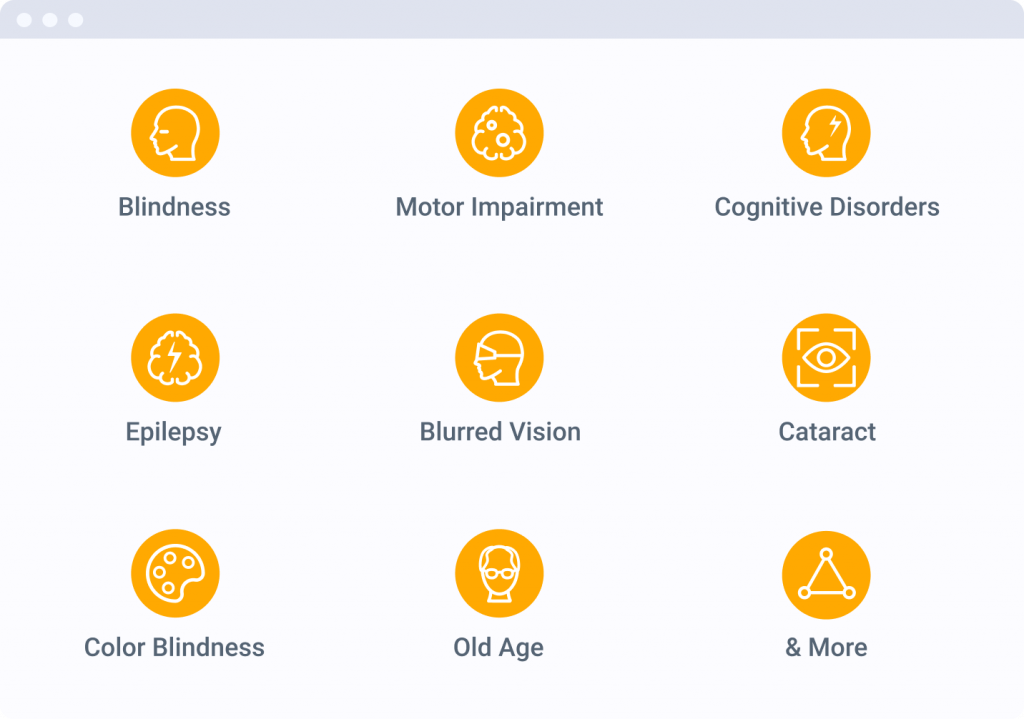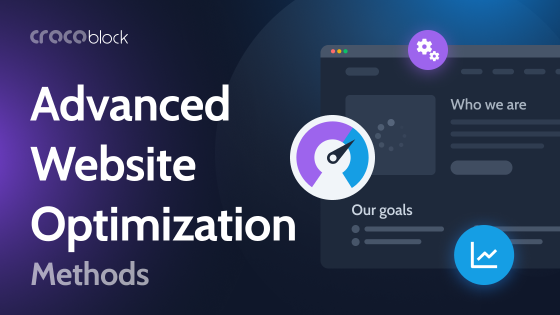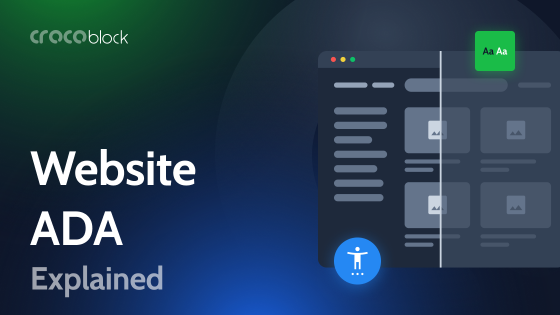Up to $75,000 for first-time violations and a $150,000 fine for every repeat violation. If you thought it was a large-scale fraud fine or something like that, well, it’s not. This is the ADA non-compliance penalty.
In this article, we will discuss ADA website compliance, WCAG standards and conformance levels, and why it’s important to abide by the website accessibility principles.
Table of Contents
- What Are ADA, Section 508, and WCAG?
- WCAG Explained
- Why It’s Important to Make Websites ADA and WCAG-Compliant
- Non-Compliant Websites and What They Entail
- Website Compliance FAQ
- Conclusion
What Are ADA, Section 508, and WCAG?
Before we dive deep into the accessibility guidelines, let’s get familiar with the terms.
ADA
ADA stands for The Americans with Disabilities Act. This is a civil rights law that prohibits discrimination against people with disabilities in all areas, including work, education, transportation, leisure, etc.
First drafted in 1990, this law didn’t include any regulations about web design. But in 2010, the U.S. Department of Justice released The ADA Standards for Accessible Design, which enforced state and local governments to provide program access to their services for those who cannot access a physical facility. This could be marked as the starting point for recognizing the importance of information technology, accessible web design, and ADA web compliance overall.
By far, ADA requires businesses, nonprofit organizations, state and local governments to provide people with disabilities with the maximum possible equal access to services, be it online or offline. Likewise, federal agencies must comply with the Rehabilitation Act and its Section 508, in particular.
Section 508
As mentioned above, Section 508 is a part of the Rehabilitation Act that requires federal agencies to develop and maintain electronics, communications, and information technology. In addition, it must be ensured that this technology is accessible to people with disabilities without causing an “undue burden.”
Section 508 purview is restricted to federal employees and businesses using government funding.
WCAG
ADA requires the strict following of the accessibility standards yet doesn’t provide any particular instructions. Hence WCAG, meaning the Web Content Accessibility Guidelines, saw the light.
WCAG, developed by the Web Accessibility Initiative (WAI), is an ISO standard (ISO/IEC 40500:2012). It comes in three conformance levels: A, AA, and AAA. In the U.S., the WCAG 2.0 A, AA standard is de facto recognized (yet not set) by the Department of Justice, the courts, and advocates.
WCAG Explained
WCAG Conformance Levels
Have you ever thought about what WCAG AA vs. AAA means? These are conformance levels, which indicate a certain level of website accessibility:
- A – Minimal compliance. Following just the minimal criteria, you cannot achieve a fully accessible and ADA-compliant website.
- AA – Acceptable compliance. Following the level AA requirements, you will get to make a usable and understandable website for most people, regardless of their disabilities. Make sure to meet all the A and AA level requirements to achieve the second compliance level.
- AAA – Maximum compliance. It is the highest score a website can receive, which means absolutely equal and maximum possible accessibility. To achieve AAA, you must fulfill all three levels of WCAG compliance requirements. At the same time, it is noted that some AAA success criteria simply can’t be met due to particular content specifics.
WCAG is updated continuously to meet all ever-emerging needs. The latest version is WCAG 2.1 of 2018, which expands WCAG 2.0 of 2008, not replacing it.
WCAG 2.0: founding principles
WCAG 2.0 Guidelines include four main principles and 12 success criteria. The document is extensive and very detailed, containing rules, guidelines, explanations, and explanations to explanations. I’ll share the summary today, but I strongly advise you to study the entire document.
NOTE
The principles outlined below are taken “as is” from the WCAG 2.0 Guidelines. We do not intend to violate the copyright and provide them unchanged for conformity purposes.
Principle 1: Perceivable. Information and user interface components must be presentable to users in ways they can perceive.
Since website content and UI can’t be visible to some people’s senses, you must strive to present them well and make them perceivable.
The success criteria include the following:
- Provide text alternatives for non-textual content.
- Provide captions, audio descriptions, and other alternatives for time-based media.
- Ensure the created content can be shown in different ways without structure or information loss.
- Facilitate the process of hearing and seeing the content.
Principle 2: Operable. User interface components and navigation must be operable.
All users must be able to operate the interface and navigate the website by performing disability-friendly interactions.
- All website features must be available from a keyboard.
- Allot users enough time to read and use the content.
- Avoid creating and using content that may cause seizures.
- Help users navigate and find the content they need.
Principle 3: Understandable. Information and the operation of user interface must be understandable.
Make sure the UI, its operation, and the presented information are not beyond the users’ understanding.
- Ensure text content is readable and comprehensible.
- Make webpage content appear and operate predictably.
- Help users avoid and correct mistakes.
Principle 4: Robust. Content must be robust enough that it can be interpreted reliably by a wide variety of user agents, including assistive technologies.
As technology advances, make sure the content remains accessible.
- Provide maximum compatibility with current and future user tools.
WCAG 2.1: mobile accessibility
As I already mentioned, WCAG 2.1 is backwards compatible with WCAG 2.0, which means that:
- the previous principles and guidelines continue operating;
- the numbering remains the same;
- three conformance levels still apply.
Version 2.1 provides 17 more success criteria for website compliance. New criteria address mobile accessibility, which no one took into account 15 years ago.
Additionally, the document addresses concerns of certain user groups not identified at the time. For instance, WCAG 2.1 comprises proper success criteria for making websites accessible to people with low vision, learning, and cognitive disabilities.
WCAG 2.2: simple authentication
Originally, WCAG 2.2 release was intended for 2020, but then it was pushed back a few times. Nevertheless, the draft is already finished and available. Its current version is scheduled to be published in April 2023. WCAG 2.2 touches upon simplified user authentication and introduces nine more success criteria to the previous version:
- 2 are at Level A;
- 5 are at Level AA;
- 2 are at Level AAA.
It seems like the team behind WCAG knows its business, as it does fulfill all the new needs very timely. For example, WCAG 2.2 includes a guideline stating that website owners must provide an alternative way to authenticate people who are unable to pass a cognitive test.
WCAG 3.0: updated conformity
The first draft of WCAG 3.0 saw the light in December 2021. Formerly known as “Silver,” the project is now called W3C Accessibility Guidelines. The name was chosen to cover the broader scope beyond the “content” notion.
So far, WCAG 3 applies to web content, publishing, tools, apps, and emerging technologies. In addition, WCAG 3.0 includes a new conformance model, a points-based system – Bronze, Silver, and Gold – which will discontinue the previous A, AA, and AAA level system. The new policy has its pros and cons.
Pros:
- Previously, if the website met all AA-level criteria but, for example, missed a single point of the A-level criteria, it wouldn’t receive any conformance status. The new grading system is much smoother and allows reasonable deviations from the standard.
- The document will likely become less confusing. For example, the guidelines will be divided into categories by different disabilities and user interactions.
- The new guidelines will include guidance on how and how much of a site needs to be tested for accessibility.
Cons:
- The minimum compliance level within the WCAG 3.0 equates to the current AA level. It means that websites with a minimum of the currently required compliance level wouldn’t comply with Bronze.
Why It’s Important to Make Websites ADA and WCAG-Compliant
WebAIM Million is a research project started at Utah State University. Since 2019, they have tested the top one million home pages for WCAG compliance. According to their latest findings, 96.8% of home pages had compliance issues and about 50.8 errors per page. For those who think their websites are in the clear, they are probably not.
Why make a website accessible? There are three main reasons to consider:
- DEI (diversity, equity, inclusion) – to acknowledge and respect the rights for digital inclusion granted to all, especially to people with disabilities.
- Opportunity – to provide equal opportunities for challenged people (those with hearing, vision, fine motor skills, cognition troubles, and more) to browse the Internet, make purchases online, use online services, etc.
- Legal – because ADA and Section 508 are legal documents, you might need protection from possible plaintiffs and lawsuits.
Compliant website benefits
Accessibility will likely affect SEO and rank your website higher in the search results – all because Google gives ranking benefits to sites that meet accessibility requirements like alt texts, etc. Another obvious thing is that the accessible sites’ bounce rate is lower, and the average visit duration is longer.
Making the website accessible
First things first, you need to test the website for ADA compliance, and automated solutions will do the trick. Since the AAA level may be unattainable for some content, the optimal practice is to conduct a 3-factor WCAG 2.1 A, AA audit.
Keep in mind that WCAG guidelines are interpretive, and only humans can understand all nuances. For maximum efficiency, it’s best to combine automated audits and human testing.
Among automated ADA solutions, I’d like to point out accessiBe. It is a fully automated web accessibility solution for ADA & WCAG compliance. It sticks to WCAG and applies AI methods to scan, examine, and adjust the website’s code and performance to fit compliance requirements.
📺 Must-watch: Live Q&A | Building ADA-compliant websites | JetTalks
AccessiBe considers the needs of people with any disability, disorder, illness, or injury, making the Internet equally accessible for everyone. In addition to timely scans, reporting, and troubleshooting, the accessiBe team offers its clients legal support.
To qualify for a disability-friendly website, you must make it accessible to people falling under the following disability categories – poor hearing, visual impairment, cognitive disorders, and declining motor skills. For that matter, you must strive to:
- create as simple navigation as possible;
- structure HTML and CSS to label all coded elements accurately;
- provide text alternatives to all multimedia content;
- design a website contrasting enough;
- avoid blinking elements in the design;
- create captions for video content replicating the spoken words and descriptions of the tone, facial expressions, etc.
Non-Compliant Websites and What They Entail
If your website is not accessible, then you have at least two things to worry about. The first is losing potential customers. The second is the lawsuits.
The number of claims against companies whose websites and mobile applications do not meet accessibility requirements grows yearly. According to the research conducted by Seyfarth, in 2020, the number of lawsuits that made it to the U.S. Federal Court amounted to 2,523. In 2021, that number rose by 14%, with a total of 2,895 lawsuits. The numbers for 2022 are 3,255 court cases, which is 12% higher than the previous year.
How to reduce the risks of ADA non-compliance lawsuits, you may wonder? Here are some steps you can take:
- Implement an ADA policy to discover if your website is accessible. Think of hiring legal counsel with accessibility experience.
- Conduct regular audits manually or use special software to check the website for ADA compliance.
- Educate IT personnel on ADA principles.
- Examine the existing lawsuits to ensure your website could not be sued for the same things.
- Ask people with disabilities to leave feedback on whether they really can use your website to the fullest.
Website Compliance FAQ
There are four main points of accessibility:
1. The content must be perceivable. Make sure it’s deliverable in several alternative ways.
2. The interface must be operable. Make sure all the site’s features are available through the keyboard.
3. The site must be understandable. Make sure the navigation is friendly for every user group.
4. The site must be robust. Make sure it won’t cause any significant validation errors.
Yes, unless you like losing clients and filing lawsuits. Ninety-seven percent of the websites fail accessibility tests, so the plaintiffs usually win the cases.
You may be at risk if your website offers online shopping, restaurant booking, banking, education, healthcare services, etc.
Yes, nonprofits must ensure their websites are accessible to people with disabilities. There are already legal cases against nonprofit organizations about their sites’ non-compliance, in which the defendant lost.
Learning how to implement accessibility is challenging. It is probably the main reason why accessibility requirements are neglected. We suggest you study the original WCAG overview to dive into the topic and take a free Web Accessibility course by Google to test your knowledge.
Conclusion
Speaking about ADA web accessibility, we mainly focus on obligations, penalties for non-compliance, and compliance benefits. What we seem to ignore is the number of people who really need this equal opportunity.
According to WHO, 16% of the global population, 1.3 billion people, experience some form of disability. Each of these people wants to enjoy all the Internet benefits the same way as others. Well, you know, buy plane tickets, read the news, shop online, book a dentist appointment – you name it. It is up to us to make it happen.
There are numerous accessibility standards, but the point is to make your own website a better place for those challenged who want fair digital inclusion.


